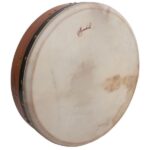Mridangam, South Indian, Tenor
The South Indian Mridangam shell is made from the wood of the Jackfruit tree. The Drum has two opposing heads, bass and tenor. Overall length is approximately 22-24 inches, the bass head is 7 1/2 – 8 1/4 inches in diameter and the tenor head is 6 1/4 – 7 1/2 inches in diameter. This drum is lace tuned. This Mridangam is the principal percussion instrument in South Indian classical Carnatic music. It functions as a solo instrument, as well as an accompaniment for vocals and ensembles.
Compared to the Northern Indian Mridangam, the Southern Mridangam tenor head has a wider outer tonal layer, known as karani. Sliver-thin reeds are inserted between the two layers of the tenor head to create a distinct, buzzed snare sound. A small dough paste is applied on the outside center of the bass head to achieve a low bass tone. There are no tuning blocks, although they can be inserted under the straps to increase the pitch. When played, the drum is held horizontally, and played with the fingers and palms of the hands.




